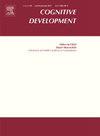From blank page to bright mind: Comparing the emotional benefits of drawing and other activities in children
IF 1.8
3区 心理学
Q3 PSYCHOLOGY, DEVELOPMENTAL
引用次数: 0
Abstract
Few studies have examined drawing as a tool for children’s emotional regulation, with some evidence suggesting it can improve emotional states, particularly when used as a distraction. However, important questions remain. This study investigated whether the emotional benefits of drawing are greater than, or comparable to, those of other engaging activities. One hundred fifty children aged 7–8 years rated their emotional state (T1), engaged in one of four activities (drawing, tangram puzzle, reading, or passive observation), and then rated their emotional state again (T2). Results show that children’s emotional state improved in the drawing, tangram, and observation conditions, but not in the reading condition. These findings suggest that emotional regulation is not specific to drawing, nor is it merely achieved by engaging in any activity, but rather depends on the nature of the activity itself. This study helps clarify how typical daily activities can influence children’s emotional regulation and underscores the value of choosing activities that support emotional well-being.
从空白页到明亮的头脑:比较绘画和其他活动对儿童的情感益处
很少有研究将绘画作为儿童情绪调节的一种工具,一些证据表明,绘画可以改善情绪状态,尤其是当它被用来分散注意力时。然而,重要的问题依然存在。这项研究调查了绘画的情感益处是否大于或可与其他引人入胜的活动相媲美。150名7-8岁的儿童对他们的情绪状态进行了评估(T1),参与了四种活动中的一种(画画、七合板拼图、阅读或被动观察),然后再次对他们的情绪状态进行了评估(T2)。结果表明,儿童的情绪状态在绘画、七巧板和观察条件下有所改善,而在阅读条件下没有改善。这些发现表明,情绪调节并不是绘画所特有的,也不仅仅是通过参与任何活动来实现的,而是取决于活动本身的性质。这项研究有助于阐明典型的日常活动如何影响儿童的情绪调节,并强调选择支持情绪健康的活动的价值。
本文章由计算机程序翻译,如有差异,请以英文原文为准。
求助全文
约1分钟内获得全文
求助全文
来源期刊

Cognitive Development
Multiple-
CiteScore
3.20
自引率
5.60%
发文量
114
期刊介绍:
Cognitive Development contains the very best empirical and theoretical work on the development of perception, memory, language, concepts, thinking, problem solving, metacognition, and social cognition. Criteria for acceptance of articles will be: significance of the work to issues of current interest, substance of the argument, and clarity of expression. For purposes of publication in Cognitive Development, moral and social development will be considered part of cognitive development when they are related to the development of knowledge or thought processes.
 求助内容:
求助内容: 应助结果提醒方式:
应助结果提醒方式:


